Entrepreneurship and Small Business: Ventures, Typologies, and Economy
VerifiedAdded on 2022/01/17
|32
|9691
|23
Report
AI Summary
This report provides a comprehensive analysis of entrepreneurship and small business management, focusing on different types of entrepreneurial ventures and their relationship to the typology of entrepreneurship. It explores small-scale, big business, and social entrepreneurship, highlighting their unique characteristics and contributions. The report also examines the similarities and differences between various entrepreneurial ventures, such as sole proprietorships, partnerships, and LLCs, in terms of licensing, startup costs, taxes, debts, and borrowing capacities. Furthermore, it assesses the impact of micro and small businesses on the economy, using data and statistics to evaluate their significance in providing employment opportunities and contributing to GDP growth. The report also differentiates between the economic impact of small, medium, and large enterprises. The study also discusses the impact of small businesses on the social economy and highlights the characteristics and skill sets required for successful entrepreneurs, differentiating them from managers. Finally, it delves into the aspects of entrepreneurial personality, motivation, and mindset, as well as the impact of background and experience on entrepreneurship.

ENTREPRENEURSHIP AND SMALL BUSINESS
MANAGEMENT
EXPLORE EDUCATION INSTITUTE
Page | 1
MANAGEMENT
EXPLORE EDUCATION INSTITUTE
Page | 1
Paraphrase This Document
Need a fresh take? Get an instant paraphrase of this document with our AI Paraphraser

Contents
1. QUESTION...........................................................................................................................................................3
1.1 Introduction:.......................................................................................................................................................3
1.2 What is Typology of Entrepreneurship?.........................................................................................................3
1.3 Entrepreneurial Ventures and Subsequent Relation to Typologies..............................................................3
2. QUESTION:.........................................................................................................................................................5
1.1 Similarities between Entrepreneurial Ventures:......................................................................................5
2.2 Differences between Entrepreneurial Ventures:.............................................................................................6
3. QUESTION:.........................................................................................................................................................7
3.1 Micro and Small Businesses- Definition:.........................................................................................................7
3.2 Micro & Small Businesses – Interpreting the Significance:...........................................................................7
3.3 Micro & Small Businesses – Impact on Economy:........................................................................................8
3.4 Economical Impact: Small, Medium & Large Enterprises:..........................................................................9
4. QUESTION:.......................................................................................................................................................10
4.1 Introduction:.....................................................................................................................................................11
4.2 Impact of Small Business to Social Economy:...............................................................................................11
5. QUESTION:.......................................................................................................................................................13
5.1 Characteristics of Successful Entrepreneurs:...............................................................................................13
5.2 Skill Sets Required to become a Successful Entrepreneur:.........................................................................14
5.3 Differentiation Table: Entrepreneurs vs. Managers:...................................................................................16
5.4 Conclusion:.......................................................................................................................................................17
6. QUESTION:.......................................................................................................................................................18
6.1 Introduction:.....................................................................................................................................................18
6.2 Aspects of Entrepreneurial Personality:........................................................................................................18
6.3 Entrepreneurial Motivation and Mindset:....................................................................................................21
7. QUESTION:.......................................................................................................................................................23
7.1 Introduction:.....................................................................................................................................................23
7.2 Background and Experience: Impact on Entrepreneurship:......................................................................23
8. QUESTION:.......................................................................................................................................................26
CONCLUSION:..........................................................................................................................................................28
REFERENCE LIST:..................................................................................................................................................29
Page | 2
1. QUESTION...........................................................................................................................................................3
1.1 Introduction:.......................................................................................................................................................3
1.2 What is Typology of Entrepreneurship?.........................................................................................................3
1.3 Entrepreneurial Ventures and Subsequent Relation to Typologies..............................................................3
2. QUESTION:.........................................................................................................................................................5
1.1 Similarities between Entrepreneurial Ventures:......................................................................................5
2.2 Differences between Entrepreneurial Ventures:.............................................................................................6
3. QUESTION:.........................................................................................................................................................7
3.1 Micro and Small Businesses- Definition:.........................................................................................................7
3.2 Micro & Small Businesses – Interpreting the Significance:...........................................................................7
3.3 Micro & Small Businesses – Impact on Economy:........................................................................................8
3.4 Economical Impact: Small, Medium & Large Enterprises:..........................................................................9
4. QUESTION:.......................................................................................................................................................10
4.1 Introduction:.....................................................................................................................................................11
4.2 Impact of Small Business to Social Economy:...............................................................................................11
5. QUESTION:.......................................................................................................................................................13
5.1 Characteristics of Successful Entrepreneurs:...............................................................................................13
5.2 Skill Sets Required to become a Successful Entrepreneur:.........................................................................14
5.3 Differentiation Table: Entrepreneurs vs. Managers:...................................................................................16
5.4 Conclusion:.......................................................................................................................................................17
6. QUESTION:.......................................................................................................................................................18
6.1 Introduction:.....................................................................................................................................................18
6.2 Aspects of Entrepreneurial Personality:........................................................................................................18
6.3 Entrepreneurial Motivation and Mindset:....................................................................................................21
7. QUESTION:.......................................................................................................................................................23
7.1 Introduction:.....................................................................................................................................................23
7.2 Background and Experience: Impact on Entrepreneurship:......................................................................23
8. QUESTION:.......................................................................................................................................................26
CONCLUSION:..........................................................................................................................................................28
REFERENCE LIST:..................................................................................................................................................29
Page | 2
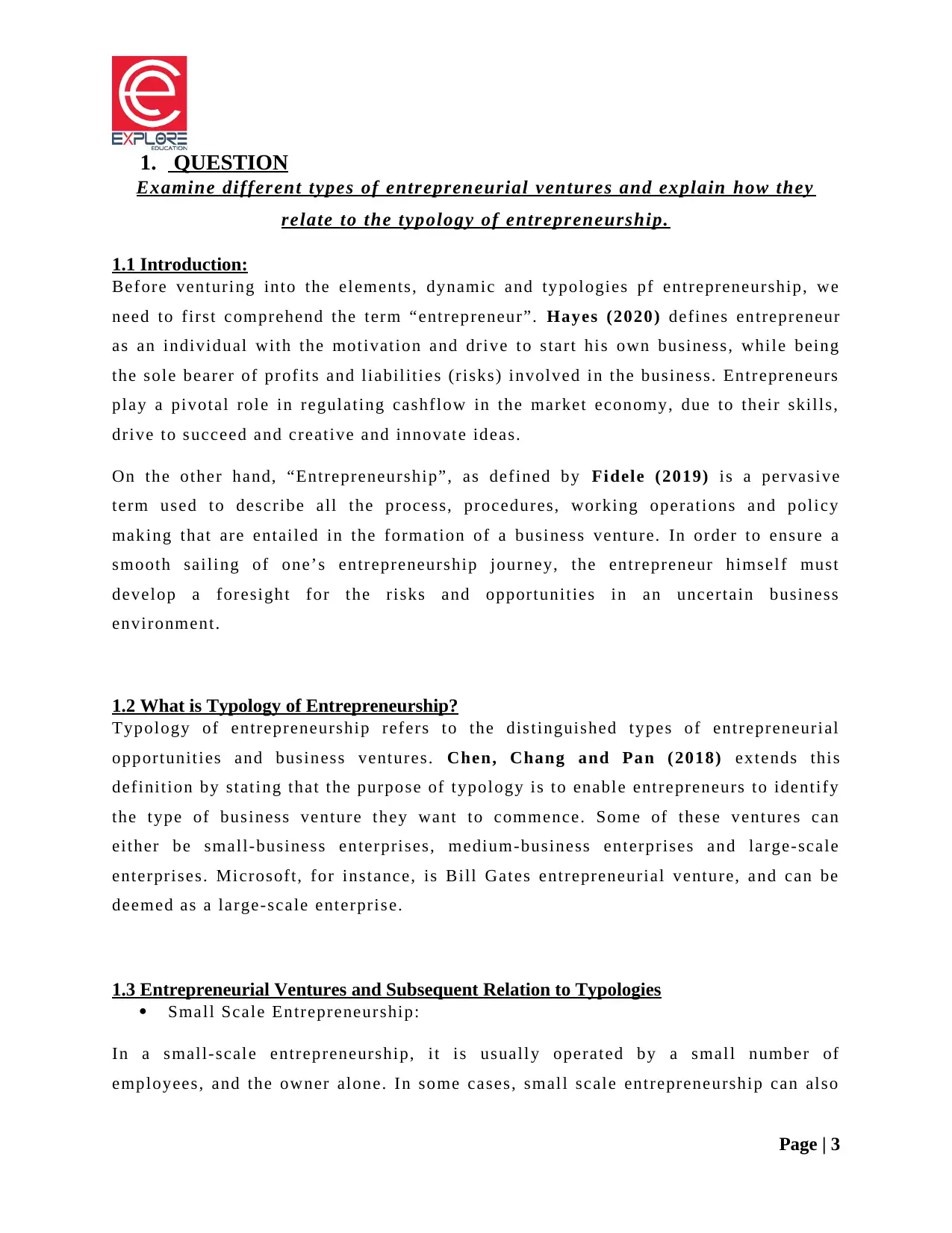
1. QUESTION
Examine different types of entrepreneurial ventures and explain how they
relate to the typology of entrepreneurship.
1.1 Introduction:
Before venturing into the elements, dynamic and typologies pf entrepreneurship, we
need to first comprehend the term “entrepreneur”. Hayes (2020) defines entrepreneur
as an individual with the motivation and drive to start his own business, while being
the sole bearer of profits and liabilities (risks) involved in the business. Entrepreneurs
play a pivotal role in regulating cashflow in the market economy, due to their skills,
drive to succeed and creative and innovate ideas.
On the other hand, “Entrepreneurship”, as defined by Fidele (2019) is a pervasive
term used to describe all the process, procedures, working operations and policy
making that are entailed in the formation of a business venture. In order to ensure a
smooth sailing of one’s entrepreneurship journey, the entrepreneur himself must
develop a foresight for the risks and opportunities in an uncertain business
environment.
1.2 What is Typology of Entrepreneurship?
Typology of entrepreneurship refers to the distinguished types of entrepreneurial
opportunities and business ventures. Chen, Chang and Pan (2018) extends this
definition by stating that the purpose of typology is to enable entrepreneurs to identify
the type of business venture they want to commence. Some of these ventures can
either be small-business enterprises, medium-business enterprises and large-scale
enterprises. Microsoft, for instance, is Bill Gates entrepreneurial venture, and can be
deemed as a large-scale enterprise.
1.3 Entrepreneurial Ventures and Subsequent Relation to Typologies
Small Scale Entrepreneurship:
In a small-scale entrepreneurship, it is usually operated by a small number of
employees, and the owner alone. In some cases, small scale entrepreneurship can also
Page | 3
Examine different types of entrepreneurial ventures and explain how they
relate to the typology of entrepreneurship.
1.1 Introduction:
Before venturing into the elements, dynamic and typologies pf entrepreneurship, we
need to first comprehend the term “entrepreneur”. Hayes (2020) defines entrepreneur
as an individual with the motivation and drive to start his own business, while being
the sole bearer of profits and liabilities (risks) involved in the business. Entrepreneurs
play a pivotal role in regulating cashflow in the market economy, due to their skills,
drive to succeed and creative and innovate ideas.
On the other hand, “Entrepreneurship”, as defined by Fidele (2019) is a pervasive
term used to describe all the process, procedures, working operations and policy
making that are entailed in the formation of a business venture. In order to ensure a
smooth sailing of one’s entrepreneurship journey, the entrepreneur himself must
develop a foresight for the risks and opportunities in an uncertain business
environment.
1.2 What is Typology of Entrepreneurship?
Typology of entrepreneurship refers to the distinguished types of entrepreneurial
opportunities and business ventures. Chen, Chang and Pan (2018) extends this
definition by stating that the purpose of typology is to enable entrepreneurs to identify
the type of business venture they want to commence. Some of these ventures can
either be small-business enterprises, medium-business enterprises and large-scale
enterprises. Microsoft, for instance, is Bill Gates entrepreneurial venture, and can be
deemed as a large-scale enterprise.
1.3 Entrepreneurial Ventures and Subsequent Relation to Typologies
Small Scale Entrepreneurship:
In a small-scale entrepreneurship, it is usually operated by a small number of
employees, and the owner alone. In some cases, small scale entrepreneurship can also
Page | 3
⊘ This is a preview!⊘
Do you want full access?
Subscribe today to unlock all pages.

Trusted by 1+ million students worldwide
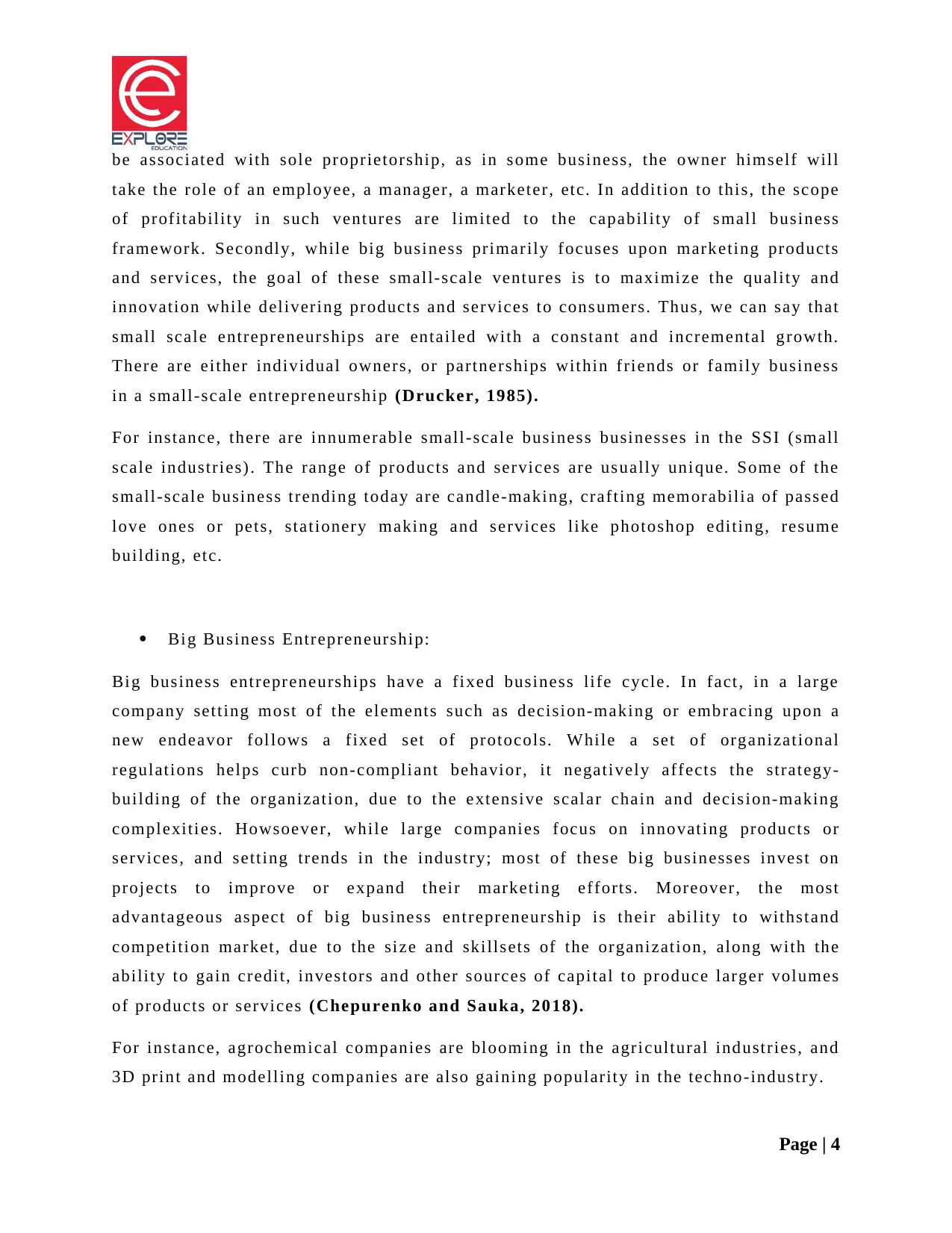
be associated with sole proprietorship, as in some business, the owner himself will
take the role of an employee, a manager, a marketer, etc. In addition to this, the scope
of profitability in such ventures are limited to the capability of small business
framework. Secondly, while big business primarily focuses upon marketing products
and services, the goal of these small-scale ventures is to maximize the quality and
innovation while delivering products and services to consumers. Thus, we can say that
small scale entrepreneurships are entailed with a constant and incremental growth.
There are either individual owners, or partnerships within friends or family business
in a small-scale entrepreneurship (Drucker, 1985).
For instance, there are innumerable small-scale business businesses in the SSI (small
scale industries). The range of products and services are usually unique. Some of the
small-scale business trending today are candle-making, crafting memorabilia of passed
love ones or pets, stationery making and services like photoshop editing, resume
building, etc.
Big Business Entrepreneurship:
Big business entrepreneurships have a fixed business life cycle. In fact, in a large
company setting most of the elements such as decision-making or embracing upon a
new endeavor follows a fixed set of protocols. While a set of organizational
regulations helps curb non-compliant behavior, it negatively affects the strategy-
building of the organization, due to the extensive scalar chain and decision-making
complexities. Howsoever, while large companies focus on innovating products or
services, and setting trends in the industry; most of these big businesses invest on
projects to improve or expand their marketing efforts. Moreover, the most
advantageous aspect of big business entrepreneurship is their ability to withstand
competition market, due to the size and skillsets of the organization, along with the
ability to gain credit, investors and other sources of capital to produce larger volumes
of products or services (Chepurenko and Sauka, 2018).
For instance, agrochemical companies are blooming in the agricultural industries, and
3D print and modelling companies are also gaining popularity in the techno-industry.
Page | 4
take the role of an employee, a manager, a marketer, etc. In addition to this, the scope
of profitability in such ventures are limited to the capability of small business
framework. Secondly, while big business primarily focuses upon marketing products
and services, the goal of these small-scale ventures is to maximize the quality and
innovation while delivering products and services to consumers. Thus, we can say that
small scale entrepreneurships are entailed with a constant and incremental growth.
There are either individual owners, or partnerships within friends or family business
in a small-scale entrepreneurship (Drucker, 1985).
For instance, there are innumerable small-scale business businesses in the SSI (small
scale industries). The range of products and services are usually unique. Some of the
small-scale business trending today are candle-making, crafting memorabilia of passed
love ones or pets, stationery making and services like photoshop editing, resume
building, etc.
Big Business Entrepreneurship:
Big business entrepreneurships have a fixed business life cycle. In fact, in a large
company setting most of the elements such as decision-making or embracing upon a
new endeavor follows a fixed set of protocols. While a set of organizational
regulations helps curb non-compliant behavior, it negatively affects the strategy-
building of the organization, due to the extensive scalar chain and decision-making
complexities. Howsoever, while large companies focus on innovating products or
services, and setting trends in the industry; most of these big businesses invest on
projects to improve or expand their marketing efforts. Moreover, the most
advantageous aspect of big business entrepreneurship is their ability to withstand
competition market, due to the size and skillsets of the organization, along with the
ability to gain credit, investors and other sources of capital to produce larger volumes
of products or services (Chepurenko and Sauka, 2018).
For instance, agrochemical companies are blooming in the agricultural industries, and
3D print and modelling companies are also gaining popularity in the techno-industry.
Page | 4
Paraphrase This Document
Need a fresh take? Get an instant paraphrase of this document with our AI Paraphraser

Social Entrepreneurship:
In a social entrepreneurship, the primary goal of the organization is to provide welfare
that benefits the community. The organization does not operate on a profit motive,
rather they focus on producing products and services that are aimed in contributing to
the society in an effective manner. The motivating factor that drives these
organizations to work towards making a better world for people, is to address social
issues like child labor, injustice to transgender women, and others (Aquino, Lück and
Schänzel, 2018).
For instance, one prime example of social entrepreneurship is micro finance
institutions, which are banks that provide loans for the low- income groups of the
society. This protects them fr4om the excessive interest rates charged by loan sharks.
Another example of social entrepreneurship is SHE (Sustainable health enterprises)
which is an African firm focused on serving feminine hygiene products to the rural or
homeless women who do not have access to them (Sustainable Health Enterprises,
2021).
2. QUESTION:
Explore the similarities and differences between entrepreneurial ventures.
1.1 Similarities between Entrepreneurial Ventures:
Basis Sole Proprietorship Partnerships and LLC
Licensing Although it is not mandatory to register a
business under a sole proprietorship, in
order to carry out a certain type of because
activity, certain state or country’s laws
require licensing and registration of the
firm. If the owner decides to globalize his
business, he will also need to obtain certain
international licenses.
Licensing and registrations are required at
the very formation of the business. No
partnership or LLC activity can be deemed
lawful without the evidence of relevant
licenses and registration of business
activities. It is also important to note that
partnerships under these business activities
are registered only for conducting legal and
Page | 5
In a social entrepreneurship, the primary goal of the organization is to provide welfare
that benefits the community. The organization does not operate on a profit motive,
rather they focus on producing products and services that are aimed in contributing to
the society in an effective manner. The motivating factor that drives these
organizations to work towards making a better world for people, is to address social
issues like child labor, injustice to transgender women, and others (Aquino, Lück and
Schänzel, 2018).
For instance, one prime example of social entrepreneurship is micro finance
institutions, which are banks that provide loans for the low- income groups of the
society. This protects them fr4om the excessive interest rates charged by loan sharks.
Another example of social entrepreneurship is SHE (Sustainable health enterprises)
which is an African firm focused on serving feminine hygiene products to the rural or
homeless women who do not have access to them (Sustainable Health Enterprises,
2021).
2. QUESTION:
Explore the similarities and differences between entrepreneurial ventures.
1.1 Similarities between Entrepreneurial Ventures:
Basis Sole Proprietorship Partnerships and LLC
Licensing Although it is not mandatory to register a
business under a sole proprietorship, in
order to carry out a certain type of because
activity, certain state or country’s laws
require licensing and registration of the
firm. If the owner decides to globalize his
business, he will also need to obtain certain
international licenses.
Licensing and registrations are required at
the very formation of the business. No
partnership or LLC activity can be deemed
lawful without the evidence of relevant
licenses and registration of business
activities. It is also important to note that
partnerships under these business activities
are registered only for conducting legal and
Page | 5
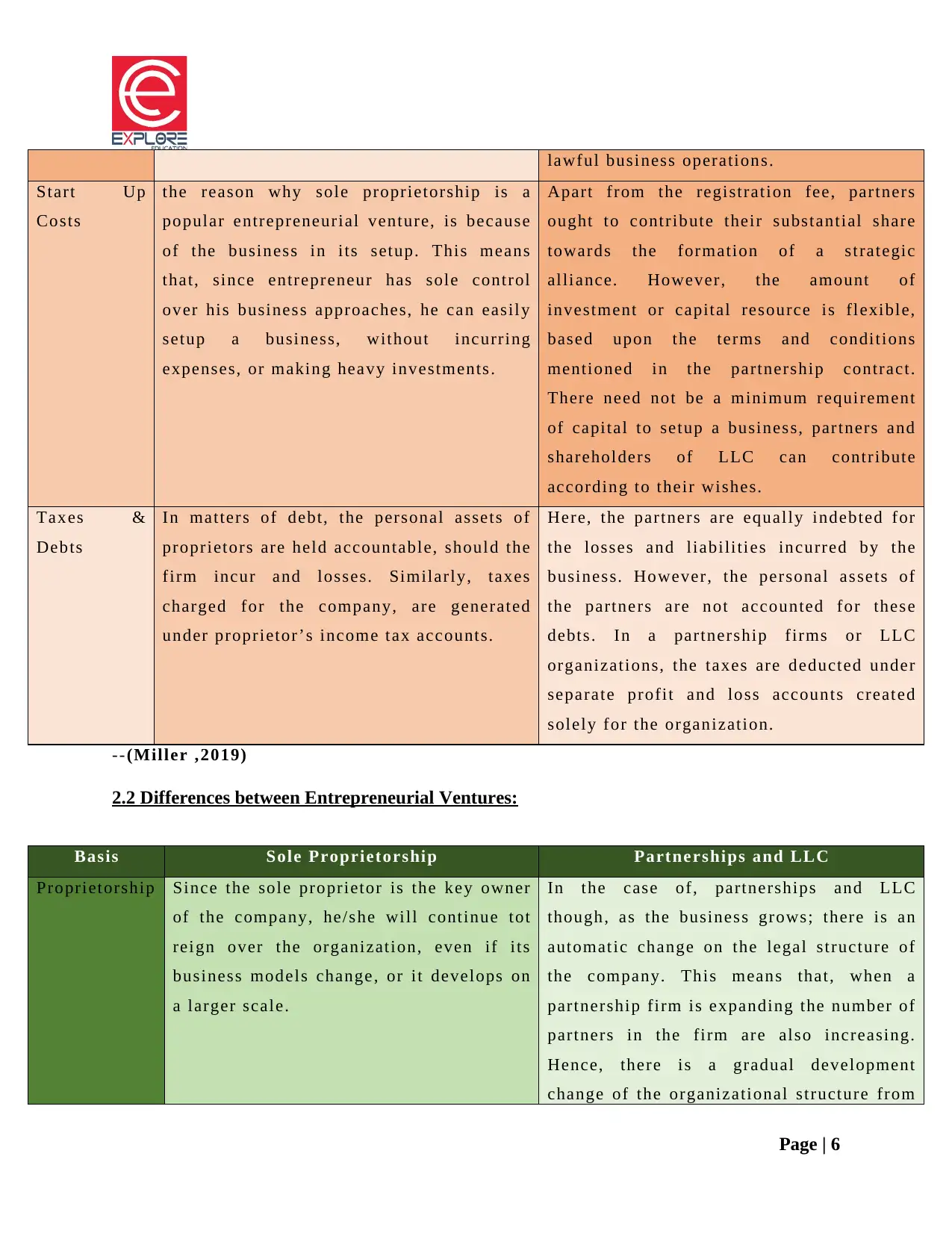
lawful business operations.
Start Up
Costs
the reason why sole proprietorship is a
popular entrepreneurial venture, is because
of the business in its setup. This means
that, since entrepreneur has sole control
over his business approaches, he can easily
setup a business, without incurring
expenses, or making heavy investments.
Apart from the registration fee, partners
ought to contribute their substantial share
towards the formation of a strategic
alliance. However, the amount of
investment or capital resource is flexible,
based upon the terms and conditions
mentioned in the partnership contract.
There need not be a minimum requirement
of capital to setup a business, partners and
shareholders of LLC can contribute
according to their wishes.
Taxes &
Debts
In matters of debt, the personal assets of
proprietors are held accountable, should the
firm incur and losses. Similarly, taxes
charged for the company, are generated
under proprietor’s income tax accounts.
Here, the partners are equally indebted for
the losses and liabilities incurred by the
business. However, the personal assets of
the partners are not accounted for these
debts. In a partnership firms or LLC
organizations, the taxes are deducted under
separate profit and loss accounts created
solely for the organization.
-- (Miller ,2019)
2.2 Differences between Entrepreneurial Ventures:
Basis Sole Proprietorship Partnerships and LLC
Proprietorship Since the sole proprietor is the key owner
of the company, he/she will continue tot
reign over the organization, even if its
business models change, or it develops on
a larger scale.
In the case of, partnerships and LLC
though, as the business grows; there is an
automatic change on the legal structure of
the company. This means that, when a
partnership firm is expanding the number of
partners in the firm are also increasing.
Hence, there is a gradual development
change of the organizational structure from
Page | 6
Start Up
Costs
the reason why sole proprietorship is a
popular entrepreneurial venture, is because
of the business in its setup. This means
that, since entrepreneur has sole control
over his business approaches, he can easily
setup a business, without incurring
expenses, or making heavy investments.
Apart from the registration fee, partners
ought to contribute their substantial share
towards the formation of a strategic
alliance. However, the amount of
investment or capital resource is flexible,
based upon the terms and conditions
mentioned in the partnership contract.
There need not be a minimum requirement
of capital to setup a business, partners and
shareholders of LLC can contribute
according to their wishes.
Taxes &
Debts
In matters of debt, the personal assets of
proprietors are held accountable, should the
firm incur and losses. Similarly, taxes
charged for the company, are generated
under proprietor’s income tax accounts.
Here, the partners are equally indebted for
the losses and liabilities incurred by the
business. However, the personal assets of
the partners are not accounted for these
debts. In a partnership firms or LLC
organizations, the taxes are deducted under
separate profit and loss accounts created
solely for the organization.
-- (Miller ,2019)
2.2 Differences between Entrepreneurial Ventures:
Basis Sole Proprietorship Partnerships and LLC
Proprietorship Since the sole proprietor is the key owner
of the company, he/she will continue tot
reign over the organization, even if its
business models change, or it develops on
a larger scale.
In the case of, partnerships and LLC
though, as the business grows; there is an
automatic change on the legal structure of
the company. This means that, when a
partnership firm is expanding the number of
partners in the firm are also increasing.
Hence, there is a gradual development
change of the organizational structure from
Page | 6
⊘ This is a preview!⊘
Do you want full access?
Subscribe today to unlock all pages.

Trusted by 1+ million students worldwide

partnerships to limited liability company.
Setting Up a
Business
Since sole proprietorship and the
organization share the same legal entity,
there is no requirement under law, for a
sole proprietor concern to be registered, in
order to start a business.
Pre-registration, respiration, licensing and
permits are required during the incubation
stage of a partnership or LLC concern.
Both, the partners and the firm are separate
entities. Hence, company under partnership
needs to be registered under separate name,
bank accounts, address, etc.
Borrowing
Capacities
Financial institutions are reluctant to
provide sole proprietors with loans
exceeding a certain limit. This is because,
since both the firm and the owner share
the same entity, banks and financial
institutions lack the motivation to provide
these firms with a substantially large
amount of capital.
Partnerships and LLC organization have
better borrowing capacities form banks
another financial institution. This is
because the credit score of all the partners
together, enable the firm in securing large
loans from the banks. Also, should the firm
enter into a dissolution phase, banks can
easily seize the assets of the business.
-- (Lazzari, 2018)
3. QUESTION:
Interpret and assess how micro and small businesses impact on the economy.
Also evaluate the difference small, medium and large businesses are making to
the economy. (Use relevant data and statistics)
3.1 Micro and Small Businesses- Definition:
Micro and small business enterprises are the legal structures of organizations that play
a pivotal role in the contribution of GDP and cashflow into the nation’s market
economy. In addition to this, due to the versatility of the market, i.e., the free entry
and exit nature of firms, micro and small businesses are the popularly desired business
ventures for first time business owners in the country. (Rao, 2020)
Page | 7
Setting Up a
Business
Since sole proprietorship and the
organization share the same legal entity,
there is no requirement under law, for a
sole proprietor concern to be registered, in
order to start a business.
Pre-registration, respiration, licensing and
permits are required during the incubation
stage of a partnership or LLC concern.
Both, the partners and the firm are separate
entities. Hence, company under partnership
needs to be registered under separate name,
bank accounts, address, etc.
Borrowing
Capacities
Financial institutions are reluctant to
provide sole proprietors with loans
exceeding a certain limit. This is because,
since both the firm and the owner share
the same entity, banks and financial
institutions lack the motivation to provide
these firms with a substantially large
amount of capital.
Partnerships and LLC organization have
better borrowing capacities form banks
another financial institution. This is
because the credit score of all the partners
together, enable the firm in securing large
loans from the banks. Also, should the firm
enter into a dissolution phase, banks can
easily seize the assets of the business.
-- (Lazzari, 2018)
3. QUESTION:
Interpret and assess how micro and small businesses impact on the economy.
Also evaluate the difference small, medium and large businesses are making to
the economy. (Use relevant data and statistics)
3.1 Micro and Small Businesses- Definition:
Micro and small business enterprises are the legal structures of organizations that play
a pivotal role in the contribution of GDP and cashflow into the nation’s market
economy. In addition to this, due to the versatility of the market, i.e., the free entry
and exit nature of firms, micro and small businesses are the popularly desired business
ventures for first time business owners in the country. (Rao, 2020)
Page | 7
Paraphrase This Document
Need a fresh take? Get an instant paraphrase of this document with our AI Paraphraser
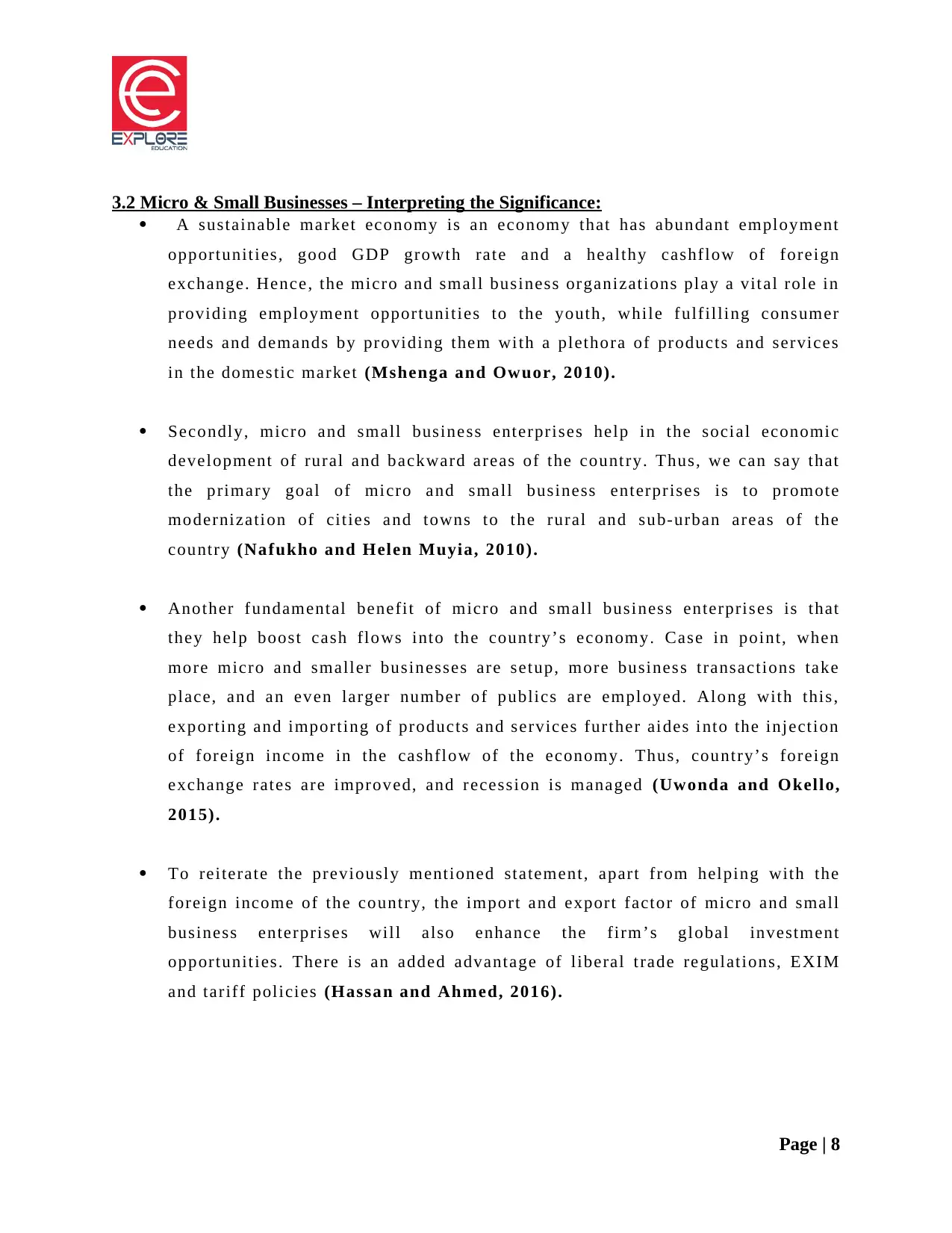
3.2 Micro & Small Businesses – Interpreting the Significance:
A sustainable market economy is an economy that has abundant employment
opportunities, good GDP growth rate and a healthy cashflow of foreign
exchange. Hence, the micro and small business organizations play a vital role in
providing employment opportunities to the youth, while fulfilling consumer
needs and demands by providing them with a plethora of products and services
in the domestic market (Mshenga and Owuor, 2010).
Secondly, micro and small business enterprises help in the social economic
development of rural and backward areas of the country. Thus, we can say that
the primary goal of micro and small business enterprises is to promote
modernization of cities and towns to the rural and sub-urban areas of the
country (Nafukho and Helen Muyia, 2010).
Another fundamental benefit of micro and small business enterprises is that
they help boost cash flows into the country’s economy. Case in point, when
more micro and smaller businesses are setup, more business transactions take
place, and an even larger number of publics are employed. Along with this,
exporting and importing of products and services further aides into the injection
of foreign income in the cashflow of the economy. Thus, country’s foreign
exchange rates are improved, and recession is managed (Uwonda and Okello,
2015).
To reiterate the previously mentioned statement, apart from helping with the
foreign income of the country, the import and export factor of micro and small
business enterprises will also enhance the firm’s global investment
opportunities. There is an added advantage of liberal trade regulations, EXIM
and tariff policies (Hassan and Ahmed, 2016).
Page | 8
A sustainable market economy is an economy that has abundant employment
opportunities, good GDP growth rate and a healthy cashflow of foreign
exchange. Hence, the micro and small business organizations play a vital role in
providing employment opportunities to the youth, while fulfilling consumer
needs and demands by providing them with a plethora of products and services
in the domestic market (Mshenga and Owuor, 2010).
Secondly, micro and small business enterprises help in the social economic
development of rural and backward areas of the country. Thus, we can say that
the primary goal of micro and small business enterprises is to promote
modernization of cities and towns to the rural and sub-urban areas of the
country (Nafukho and Helen Muyia, 2010).
Another fundamental benefit of micro and small business enterprises is that
they help boost cash flows into the country’s economy. Case in point, when
more micro and smaller businesses are setup, more business transactions take
place, and an even larger number of publics are employed. Along with this,
exporting and importing of products and services further aides into the injection
of foreign income in the cashflow of the economy. Thus, country’s foreign
exchange rates are improved, and recession is managed (Uwonda and Okello,
2015).
To reiterate the previously mentioned statement, apart from helping with the
foreign income of the country, the import and export factor of micro and small
business enterprises will also enhance the firm’s global investment
opportunities. There is an added advantage of liberal trade regulations, EXIM
and tariff policies (Hassan and Ahmed, 2016).
Page | 8
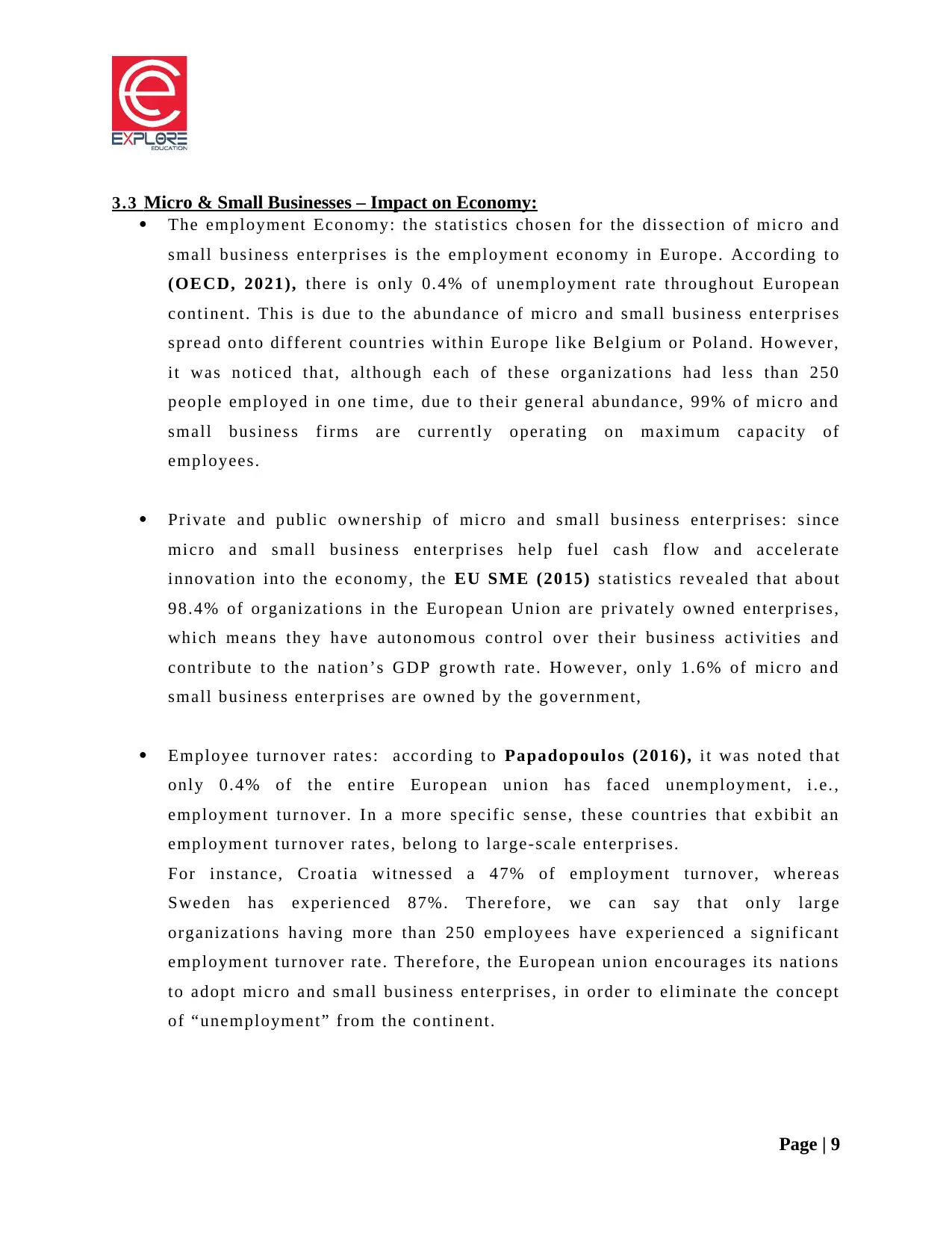
3.3 Micro & Small Businesses – Impact on Economy:
The employment Economy: the statistics chosen for the dissection of micro and
small business enterprises is the employment economy in Europe. According to
(OECD, 2021), there is only 0.4% of unemployment rate throughout European
continent. This is due to the abundance of micro and small business enterprises
spread onto different countries within Europe like Belgium or Poland. However,
it was noticed that, although each of these organizations had less than 250
people employed in one time, due to their general abundance, 99% of micro and
small business firms are currently operating on maximum capacity of
employees.
Private and public ownership of micro and small business enterprises: since
micro and small business enterprises help fuel cash flow and accelerate
innovation into the economy, the EU SME (2015) statistics revealed that about
98.4% of organizations in the European Union are privately owned enterprises,
which means they have autonomous control over their business activities and
contribute to the nation’s GDP growth rate. However, only 1.6% of micro and
small business enterprises are owned by the government,
Employee turnover rates: according to Papadopoulos (2016), it was noted that
only 0.4% of the entire European union has faced unemployment, i.e.,
employment turnover. In a more specific sense, these countries that exbibit an
employment turnover rates, belong to large-scale enterprises.
For instance, Croatia witnessed a 47% of employment turnover, whereas
Sweden has experienced 87%. Therefore, we can say that only large
organizations having more than 250 employees have experienced a significant
employment turnover rate. Therefore, the European union encourages its nations
to adopt micro and small business enterprises, in order to eliminate the concept
of “unemployment” from the continent.
Page | 9
The employment Economy: the statistics chosen for the dissection of micro and
small business enterprises is the employment economy in Europe. According to
(OECD, 2021), there is only 0.4% of unemployment rate throughout European
continent. This is due to the abundance of micro and small business enterprises
spread onto different countries within Europe like Belgium or Poland. However,
it was noticed that, although each of these organizations had less than 250
people employed in one time, due to their general abundance, 99% of micro and
small business firms are currently operating on maximum capacity of
employees.
Private and public ownership of micro and small business enterprises: since
micro and small business enterprises help fuel cash flow and accelerate
innovation into the economy, the EU SME (2015) statistics revealed that about
98.4% of organizations in the European Union are privately owned enterprises,
which means they have autonomous control over their business activities and
contribute to the nation’s GDP growth rate. However, only 1.6% of micro and
small business enterprises are owned by the government,
Employee turnover rates: according to Papadopoulos (2016), it was noted that
only 0.4% of the entire European union has faced unemployment, i.e.,
employment turnover. In a more specific sense, these countries that exbibit an
employment turnover rates, belong to large-scale enterprises.
For instance, Croatia witnessed a 47% of employment turnover, whereas
Sweden has experienced 87%. Therefore, we can say that only large
organizations having more than 250 employees have experienced a significant
employment turnover rate. Therefore, the European union encourages its nations
to adopt micro and small business enterprises, in order to eliminate the concept
of “unemployment” from the continent.
Page | 9
⊘ This is a preview!⊘
Do you want full access?
Subscribe today to unlock all pages.

Trusted by 1+ million students worldwide

3.4 Economical Impact: Small, Medium & Large Enterprises:
ECONOMY
Small
Enterprises
Small business enterprises help develop local economies and
enhance the domestic market. Moreover, they significantly
contribute to the GDP of a country. In a larger sense, it can be
observed that small business are the pedestals to largest
corporations, and hence, they promote to the growth of a country’s
market economy by lowering employment turnover rates, and
unemployment rates are at bare minimum. Small business also aide
to the development of socio-economic and cultural background of
the country. They help for the infrastructural development of
poorer geographic regions in the nation (Brown, 2018).
Medium
Enterprises
Medium enterprises are the rising trend around the world. This
means that rater than investing in large resources and grasping
onto voluminous business risks, many entrepreneurs today aim to
build a business empire by venturing to small business enterprises.
For instance, in Dubai, about 95% of the emirate is owned by small
and medium enterprises. In addition to this, about 42% of the
country’s workforce, employed in medium enterprise contribute to
40% of Dubai’s GDP (TDRA, 2021).
Large
Enterprises
Large organizations help lead the industry and mankind with
innovation. Owing to the greater financial resources, large scale
organization are capable to produce better quality products and
services for the common public. Also, the technological
advancement and infrastructural developments witnessed in a
country is solely due to the enormous contributions large scale
organizations make towards the GDP of the nation. Higher wages,
better health and retirement benefits, job stability, compensation,
etc., are the added advantages provided by large scale
organizations to promote better job economy (Country Studies,
2018).
Page | 10
ECONOMY
Small
Enterprises
Small business enterprises help develop local economies and
enhance the domestic market. Moreover, they significantly
contribute to the GDP of a country. In a larger sense, it can be
observed that small business are the pedestals to largest
corporations, and hence, they promote to the growth of a country’s
market economy by lowering employment turnover rates, and
unemployment rates are at bare minimum. Small business also aide
to the development of socio-economic and cultural background of
the country. They help for the infrastructural development of
poorer geographic regions in the nation (Brown, 2018).
Medium
Enterprises
Medium enterprises are the rising trend around the world. This
means that rater than investing in large resources and grasping
onto voluminous business risks, many entrepreneurs today aim to
build a business empire by venturing to small business enterprises.
For instance, in Dubai, about 95% of the emirate is owned by small
and medium enterprises. In addition to this, about 42% of the
country’s workforce, employed in medium enterprise contribute to
40% of Dubai’s GDP (TDRA, 2021).
Large
Enterprises
Large organizations help lead the industry and mankind with
innovation. Owing to the greater financial resources, large scale
organization are capable to produce better quality products and
services for the common public. Also, the technological
advancement and infrastructural developments witnessed in a
country is solely due to the enormous contributions large scale
organizations make towards the GDP of the nation. Higher wages,
better health and retirement benefits, job stability, compensation,
etc., are the added advantages provided by large scale
organizations to promote better job economy (Country Studies,
2018).
Page | 10
Paraphrase This Document
Need a fresh take? Get an instant paraphrase of this document with our AI Paraphraser
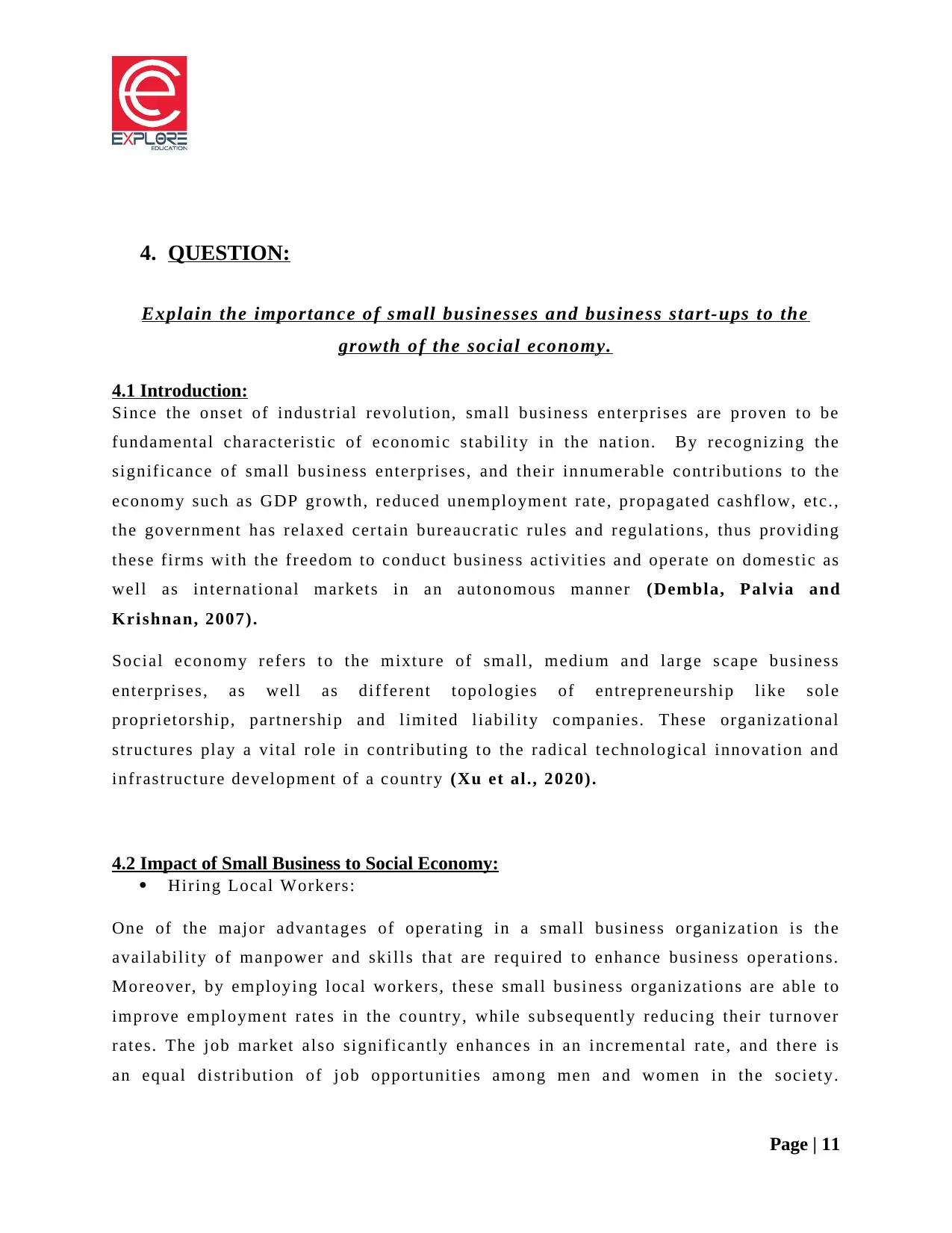
4. QUESTION:
Explain the importance of small businesses and business start-ups to the
growth of the social economy.
4.1 Introduction:
Since the onset of industrial revolution, small business enterprises are proven to be
fundamental characteristic of economic stability in the nation. By recognizing the
significance of small business enterprises, and their innumerable contributions to the
economy such as GDP growth, reduced unemployment rate, propagated cashflow, etc.,
the government has relaxed certain bureaucratic rules and regulations, thus providing
these firms with the freedom to conduct business activities and operate on domestic as
well as international markets in an autonomous manner (Dembla, Palvia and
Krishnan, 2007).
Social economy refers to the mixture of small, medium and large scape business
enterprises, as well as different topologies of entrepreneurship like sole
proprietorship, partnership and limited liability companies. These organizational
structures play a vital role in contributing to the radical technological innovation and
infrastructure development of a country (Xu et al., 2020).
4.2 Impact of Small Business to Social Economy:
Hiring Local Workers:
One of the major advantages of operating in a small business organization is the
availability of manpower and skills that are required to enhance business operations.
Moreover, by employing local workers, these small business organizations are able to
improve employment rates in the country, while subsequently reducing their turnover
rates. The job market also significantly enhances in an incremental rate, and there is
an equal distribution of job opportunities among men and women in the society.
Page | 11
Explain the importance of small businesses and business start-ups to the
growth of the social economy.
4.1 Introduction:
Since the onset of industrial revolution, small business enterprises are proven to be
fundamental characteristic of economic stability in the nation. By recognizing the
significance of small business enterprises, and their innumerable contributions to the
economy such as GDP growth, reduced unemployment rate, propagated cashflow, etc.,
the government has relaxed certain bureaucratic rules and regulations, thus providing
these firms with the freedom to conduct business activities and operate on domestic as
well as international markets in an autonomous manner (Dembla, Palvia and
Krishnan, 2007).
Social economy refers to the mixture of small, medium and large scape business
enterprises, as well as different topologies of entrepreneurship like sole
proprietorship, partnership and limited liability companies. These organizational
structures play a vital role in contributing to the radical technological innovation and
infrastructure development of a country (Xu et al., 2020).
4.2 Impact of Small Business to Social Economy:
Hiring Local Workers:
One of the major advantages of operating in a small business organization is the
availability of manpower and skills that are required to enhance business operations.
Moreover, by employing local workers, these small business organizations are able to
improve employment rates in the country, while subsequently reducing their turnover
rates. The job market also significantly enhances in an incremental rate, and there is
an equal distribution of job opportunities among men and women in the society.
Page | 11
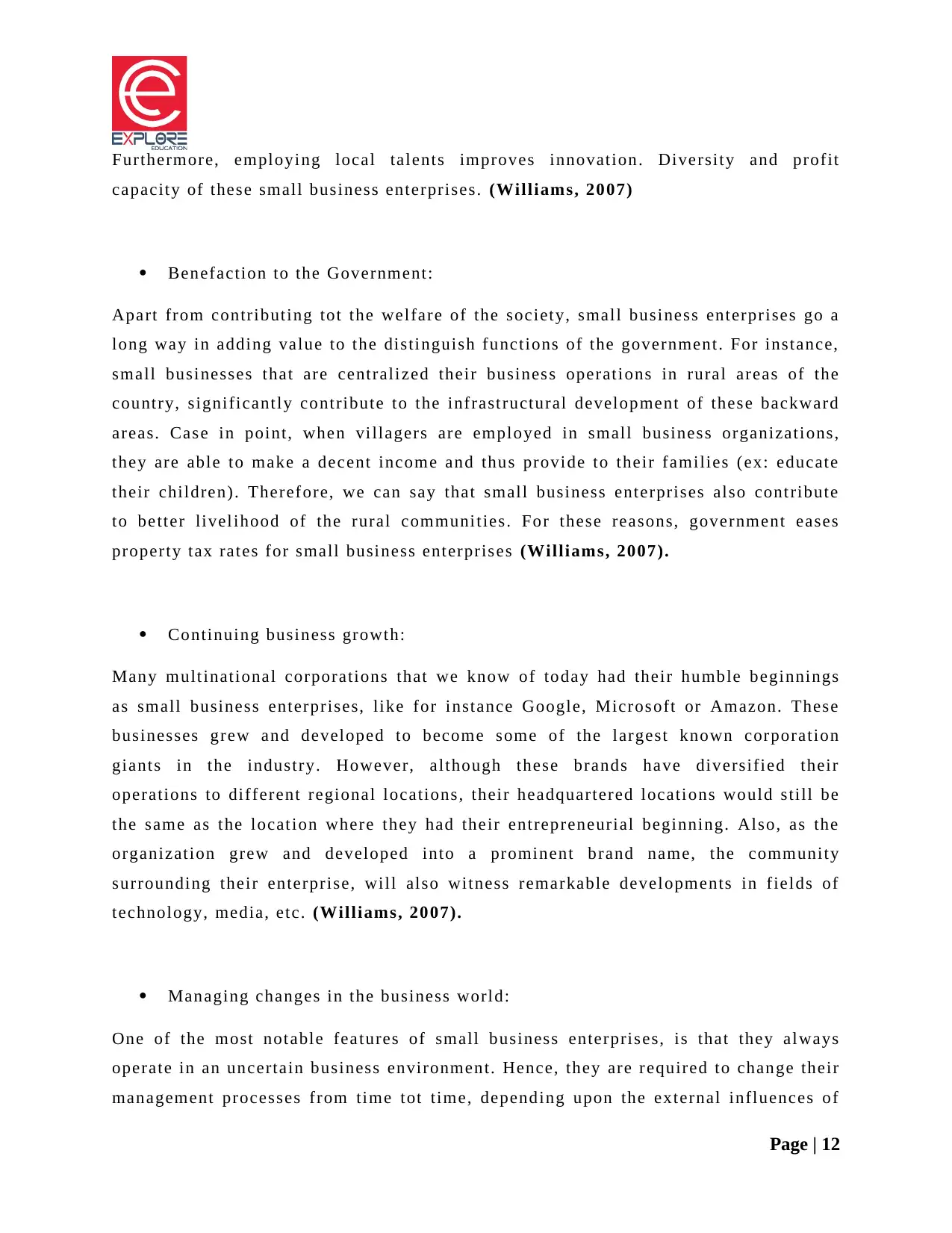
Furthermore, employing local talents improves innovation. Diversity and profit
capacity of these small business enterprises. (Williams, 2007)
Benefaction to the Government:
Apart from contributing tot the welfare of the society, small business enterprises go a
long way in adding value to the distinguish functions of the government. For instance,
small businesses that are centralized their business operations in rural areas of the
country, significantly contribute to the infrastructural development of these backward
areas. Case in point, when villagers are employed in small business organizations,
they are able to make a decent income and thus provide to their families (ex: educate
their children). Therefore, we can say that small business enterprises also contribute
to better livelihood of the rural communities. For these reasons, government eases
property tax rates for small business enterprises (Williams, 2007).
Continuing business growth:
Many multinational corporations that we know of today had their humble beginnings
as small business enterprises, like for instance Google, Microsoft or Amazon. These
businesses grew and developed to become some of the largest known corporation
giants in the industry. However, although these brands have diversified their
operations to different regional locations, their headquartered locations would still be
the same as the location where they had their entrepreneurial beginning. Also, as the
organization grew and developed into a prominent brand name, the community
surrounding their enterprise, will also witness remarkable developments in fields of
technology, media, etc. (Williams, 2007).
Managing changes in the business world:
One of the most notable features of small business enterprises, is that they always
operate in an uncertain business environment. Hence, they are required to change their
management processes from time tot time, depending upon the external influences of
Page | 12
capacity of these small business enterprises. (Williams, 2007)
Benefaction to the Government:
Apart from contributing tot the welfare of the society, small business enterprises go a
long way in adding value to the distinguish functions of the government. For instance,
small businesses that are centralized their business operations in rural areas of the
country, significantly contribute to the infrastructural development of these backward
areas. Case in point, when villagers are employed in small business organizations,
they are able to make a decent income and thus provide to their families (ex: educate
their children). Therefore, we can say that small business enterprises also contribute
to better livelihood of the rural communities. For these reasons, government eases
property tax rates for small business enterprises (Williams, 2007).
Continuing business growth:
Many multinational corporations that we know of today had their humble beginnings
as small business enterprises, like for instance Google, Microsoft or Amazon. These
businesses grew and developed to become some of the largest known corporation
giants in the industry. However, although these brands have diversified their
operations to different regional locations, their headquartered locations would still be
the same as the location where they had their entrepreneurial beginning. Also, as the
organization grew and developed into a prominent brand name, the community
surrounding their enterprise, will also witness remarkable developments in fields of
technology, media, etc. (Williams, 2007).
Managing changes in the business world:
One of the most notable features of small business enterprises, is that they always
operate in an uncertain business environment. Hence, they are required to change their
management processes from time tot time, depending upon the external influences of
Page | 12
⊘ This is a preview!⊘
Do you want full access?
Subscribe today to unlock all pages.

Trusted by 1+ million students worldwide
1 out of 32
Related Documents
Your All-in-One AI-Powered Toolkit for Academic Success.
+13062052269
info@desklib.com
Available 24*7 on WhatsApp / Email
![[object Object]](/_next/static/media/star-bottom.7253800d.svg)
Unlock your academic potential
Copyright © 2020–2025 A2Z Services. All Rights Reserved. Developed and managed by ZUCOL.


